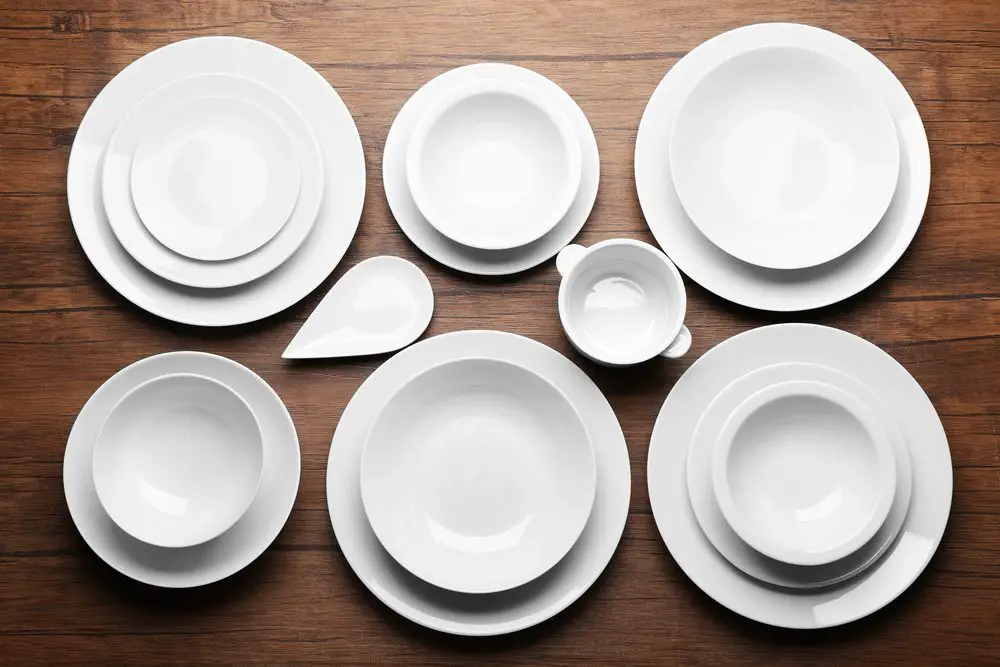Discovering that your favorite set of dishes might contain lead can be unsettling. Imagine preparing a heartwarming family dinner, laying the table with those beautiful plates you inherited from your grandmother or picked up at a quaint flea market, only to wonder if they’re safe to use. The question, “How to tell if dishes have lead,” becomes more than just a matter of curiosity—it’s about the safety and health of you and your loved ones.
Key Takeaways:
- Check dishes for manufacturer’s marks or labels showing lead content. Pay special attention to those labeled “Decorative use only” as they might contain lead.
- To assess lead risk, use lead test kits and look for visual signs such as bright colors or decorations.
- Look up the dish manufacturer and consider getting a professional opinion to accurately determine lead content, especially for valuable or heirloom items.
- Be aware that lead exposure can seriously harm health, affecting both mental and physical well-being, particularly in children, pregnant women, and adults.
- To reduce lead exposure, choose dishes marked as “Lead-Free,” use lead test kits on items you’re concerned about, and practice safe food handling and storage.
Whether it’s a vintage set that’s been in your family for generations or a recent thrift store find that caught your eye, it’s crucial to ensure that your dishes are safe for everyday use. Here’s a comprehensive guide to demystifying the process and giving you peace of mind.
Understanding Lead
Lead, known by the symbol Pb (from the Latin ‘plumbum,’ meaning ‘liquid silver’), is a heavy metal that has been part of human history for thousands of years. Its versatility and ease of extraction made it popular for various uses, from plumbing and paint to gasoline additives and batteries. And yes, including the glazes and paints of ceramics and pottery.
Historically, its ability to enhance colors and ensure a smooth, durable finish made it a popular choice. However, as we’ve grown wiser about the harmful effects of lead, its presence in our dishes has become a cause for concern.
Identifying Lead in Dishes
Identifying dishes that pose a higher risk for lead content is crucial for ensuring the safety of your household. This assessment involves understanding which dishes are most likely to contain lead based on their manufacturing process, age, origin, and appearance.
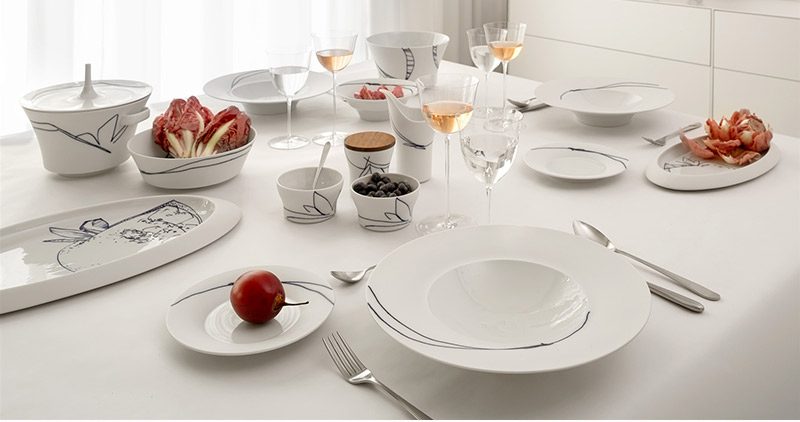
1. Inspect the Dishes for Marks or Labels
Start by looking for manufacturer stamps, marks, or labels on your dishes. Manufacturers may include information about the dish’s composition, including whether it is lead-free. Pay special attention to items marked as “Not for food use” or “Decorative use only,” as these are red flags indicating the potential presence of lead.
Understanding the Difference: Lead-Safe vs Lead-Free in Labels
When navigating the aisles of your favorite eco-friendly store or scrolling through pages of online sustainable shops, you might notice some products proudly displaying “Lead-Free” labels while others say “Lead-Safe.”
What do they mean?
Lead-Free
This label is the superhero of the story. Products boasting this label contain no detectable levels of lead. It’s the gold standard for ensuring that the products you bring into your home are safe from this toxin.
Opting for lead-free items means taking a stand against lead exposure and safeguarding your family’s health and well-being. It’s akin to choosing the path with the least obstacles for a cleaner, healthier environment at home.
Lead-Safe
Now, this label is more complex. “Lead-Safe” doesn’t mean an item is devoid of lead; rather, it implies that the lead content is below the current safety thresholds set by regulatory bodies.
However, as research evolves and our understanding of lead’s impact deepens, these “safe” thresholds can change. What’s deemed safe today might not be tomorrow.
Opting for lead-safe items requires a balance of caution and trust and an understanding that while the risk is minimized, it’s not eliminated.
2. Use a Lead Test Kit
Lead test kits are a straightforward and accessible way to check for lead on the surface of your dishes. These kits usually include swabs that change color if lead is detected. It’s essential to follow the kit’s instructions carefully for accurate results. Testing multiple areas, especially on colored glazes, is advisable as lead distribution can be uneven.
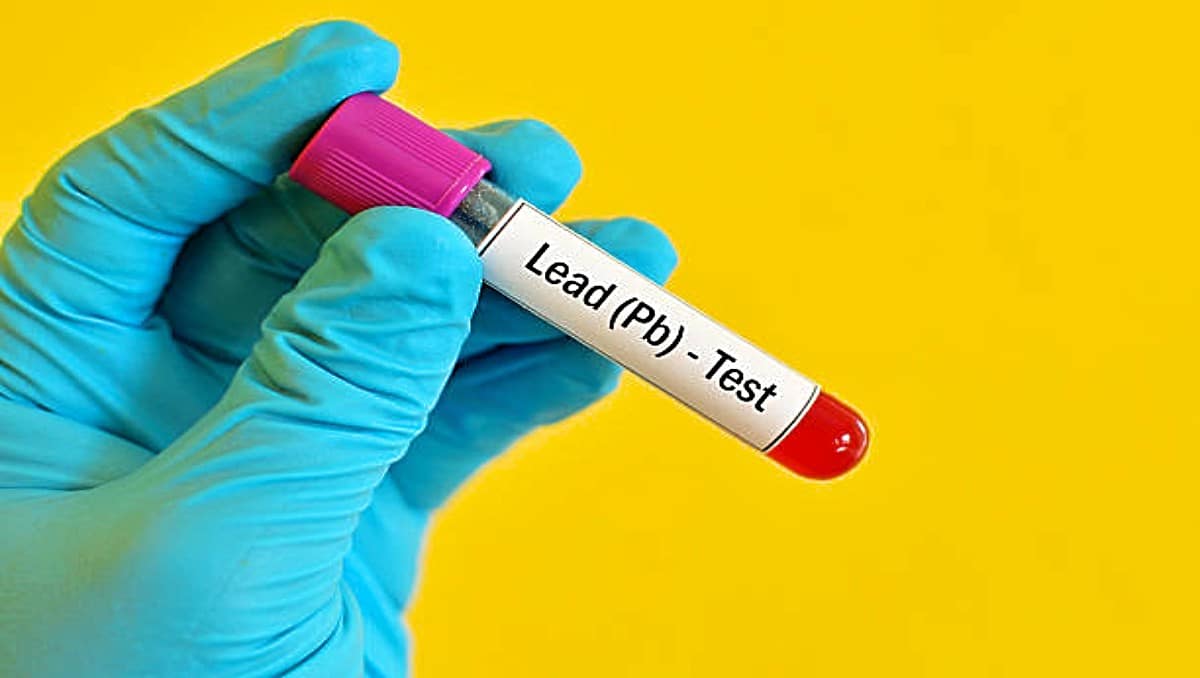
DIY Kits vs. Professional Analysis
DIY lead testing kits are available at most hardware stores or online, offering a convenient and immediate way to screen for lead in various household items.
Using them is pretty straightforward – swab the item, apply the testing solution, and wait for the color change that indicates the presence of lead. It sounds simple and can be a practical first step in identifying potential lead hazards in your home.
I’ve used these kits myself, testing everything from vintage dinner plates to the soil in my garden, and I’ve found them to be a helpful starting point in my lead-reduction journey.
However, it’s crucial to remember that these kits have their limitations. They’re designed to detect surface lead, meaning they might miss lead leaching from beneath a non-lead surface layer or in amounts below the kit’s detection limit. Interpreting the results can sometimes feel like reading tea leaves – a bit ambiguous.
3. Look for Visual Clues
Lead was commonly used in glazes and paints to achieve bright, vibrant colors such as orange, red, yellow, and green. Dishes with these colors or intricate painted designs over the glaze instead of under it might have higher lead levels.
The lead in the glaze or paint helps improve the durability and appearance of these colors, but it can also leach into food and drinks, mainly when the dish is used to serve acidic foods like citrus fruits or tomato-based sauces.
Lead in ceramics can be tricky to detect without laboratory tests, but specific visual cues can serve as initial indicators.
So, how can you tell if your dishes might expose you to lead? Here are some key signs:
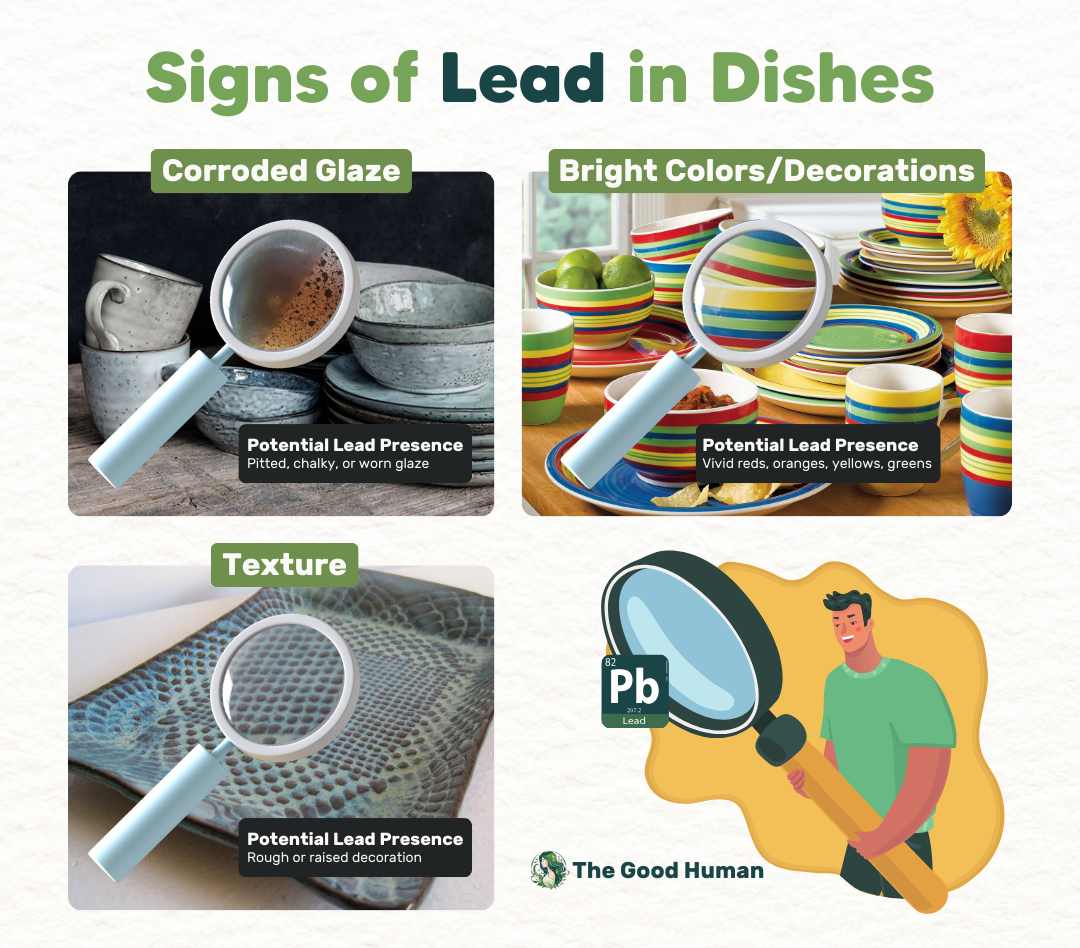
The condition of the dish plays a significant role in its potential to leach lead. Dishes that show signs of wear, such as chips, cracks, or fading, are more likely to release lead into food.
The protective glaze over the paint can deteriorate over time or become damaged, increasing the risk of lead exposure. It’s advisable to closely inspect your dishes for any signs of damage and consider their safety before use.
Also, not all ceramics are created equal. High-fired ceramics typically contain less lead, as the high temperatures in the firing process can burn off lead and other impurities. Conversely, low-fired ceramics, fired at lower temperatures, are more prone to contain lead. Handcrafted pottery, unless certified as lead-free, can also be a concern due to the traditional methods and materials used.
4. Research the Manufacturer
Researching the dish manufacturer can provide insights into their use of lead. This step is handy for newer dishes where the manufacturer may have published information about their materials and safety standards online. For older or antique dishes, consulting collectibles guides or experts can offer clues about the potential for lead.

5. Consult Antiques or Collectibles Guides
Antique guides and databases can be invaluable resources for vintage or antique dishes. These guides may list specific patterns, brands, or production years known to contain lead, helping you assess the risk of your items.
6. Get a Professional Evaluation
Consider a professional evaluation if you’re dealing with valuable or heirloom dishes and need definitive answers. Professionals can use advanced techniques to detect lead without damaging the dish. This option is particularly recommended for items you plan to use frequently.
Professional testing involves sending a sample of your item to a laboratory, where experts use sophisticated techniques like XRF (X-ray fluorescence) or ICP-MS (Inductively Coupled Plasma Mass Spectrometry) to measure lead content accurately. This option offers a detailed analysis that can detect even trace amounts of lead, giving you peace of mind or a clear direction on how to proceed.
7. Understand the Results and Take Action
After testing for lead, it’s crucial to understand what your results mean. A positive test indicates the presence of lead, but it doesn’t automatically mean you can’t use the dishes. Decisions should be based on the level of lead detected, the type of dish, and how you plan to use it. For example, dishes with minor lead content might only be reserved for decorative purposes.
The Health Impacts of Lead Exposure
Lead is a heavy metal that, for decades, was used in paint, plumbing, and even children’s toys. Though its use has significantly declined, lead’s legacy lingers in older homes, water pipes, and even the soil we grow our food.
The problem? Lead is a master of disguise, often hidden in plain sight, making exposure all too easy.
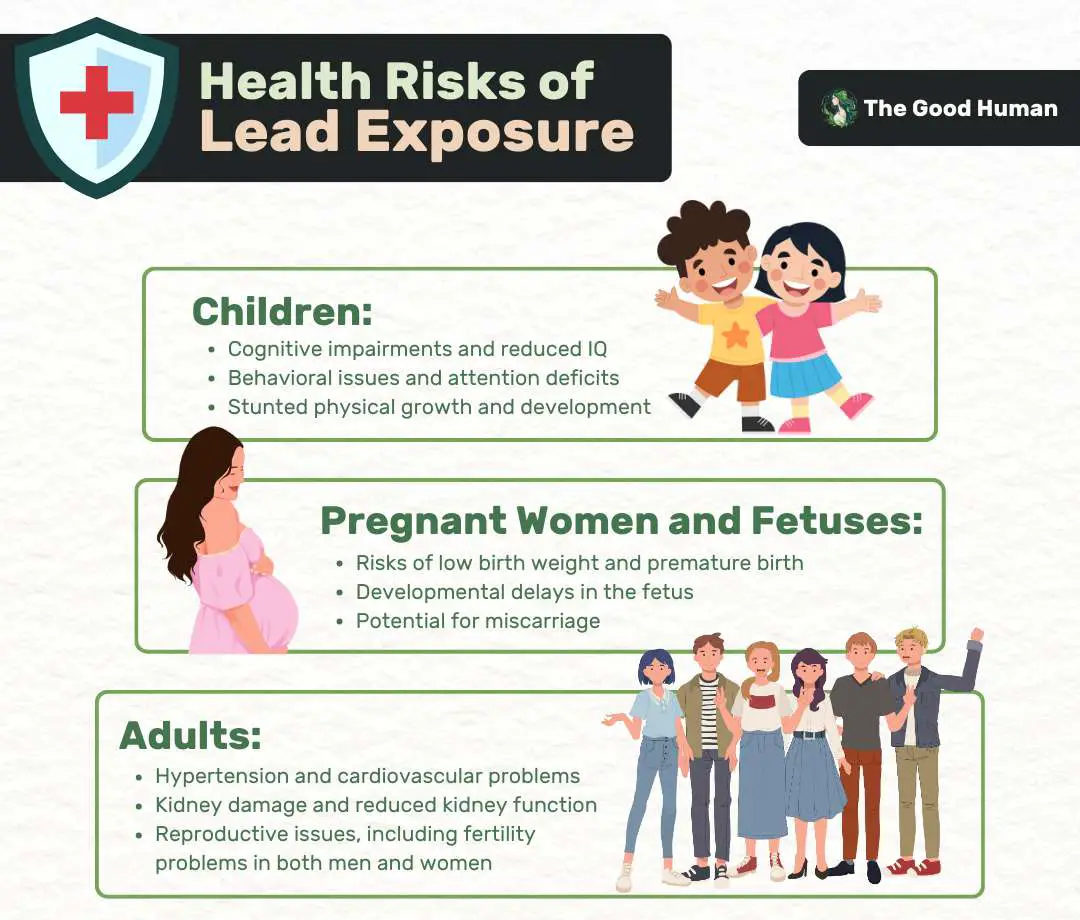
On Children
It’s heart-wrenching, isn’t it? The thought of our youngest, most innocent members of society being silently harmed by something as preventable as lead exposure. For children, lead is not just another environmental hazard—it’s a thief, stealthily stealing away potential, bit by bit.
You see, children are more susceptible to lead poisoning because they absorb lead more efficiently than adults do, and their developing brains are more vulnerable to its toxic effects.
Kids are more at risk than adults because their bodies absorb lead more quickly, and they’re often in environments where they might come into contact with lead, like playing on the floor or putting objects in their mouths.
And the most problematic part?
Lead exposure during childhood can cause lifelong psychological problems. One particular study found that children who were exposed to lead tend to have lower IQ levels, are more likely to drop out of school and show more conduct problems compared to those who weren’t exposed.

Let me share a story that puts things into perspective.
A few years back, I volunteered with a local health clinic to conduct lead screening for children in a historically industrial neighborhood. There, I met a spirited little girl named Lily, whose laughter could light up any room.
Sadly, Lily had elevated lead levels in her blood. Witnessing the worry in her parents’ eyes and the subsequent journey they embarked on to safeguard her future was a stark reminder of the urgency of this issue.
On Pregnant Women and Fetuses
For expectant mothers and their unborn children, lead exposure introduces an unwelcome risk. Lead has the sinister ability to cross the placental barrier, impacting the fetus with equal disregard.
Pregnancy-related lead exposure has significant dangers that impact the fetus’s overall development in addition to its physical health. Low birth weight, premature birth, and developmental delays are just the tip of the iceberg, making it imperative for expectant mothers to minimize their lead exposure.
Now, while you don’t need to get tested for lead exposure while pregnant, you should still consider it if you know you’ve been exposed. It is crucial if you plan on breastfeeding.
According to Jenifer Fahey, an assistant professor at the University of Maryland School of Medicine and a certified nurse midwife affiliated with the University of Maryland Medical Center’s Midtown Campus:
“The health benefits that both mom and baby receive from breastfeeding are significant, and I would hate for women to stop breastfeeding out of fear.Get tested while still pregnant. Breastfeeding is still considered safe if you have a blood lead level less than 40 micrograms/dL.”
Adults
While pregnant women and children receive justifiably more attention, adults also suffer significantly from the harsh effects of lead.
This study investigated the effects of low-level lead exposure on blood pressure among male workers in South Korea. Despite previously limited information on the impact of low blood lead levels (less than 10 μg/dL) on hypertension, this research aimed to clarify the relationship.
By examining over 7,000 workers exposed to lead, the study categorized participants based on their lead levels. It analyzed how these levels correlated with changes in blood pressure and the risk of developing high blood pressure.
The findings revealed a clear association: even minimal increases in blood lead levels were linked to slight but significant increases in systolic and diastolic blood pressure.
Notably, men in the highest lead exposure group (but still under 10 μg/dL) showed a significantly greater likelihood of having high blood pressure compared to those in the lowest exposure group.
Preventive Measures and Safety Precautions
Whether it’s the vintage plates you’ve inherited or those eye-catching ceramics you couldn’t resist at the market, ensuring they’re safe is paramount for your peace of mind.
Here are some tips to help you do just that:
Proper dish selection
The first step is choosing the right dishes. Think of it as selecting your armor in the battle against lead exposure.
When shopping for new dishes, look for those labeled “Lead-Free.” Be familiar with the origin of the ceramics; some countries have stricter regulations regarding lead in dishware. Remember, the beauty of a dish is not just in its appearance but in its safety and sustainability.
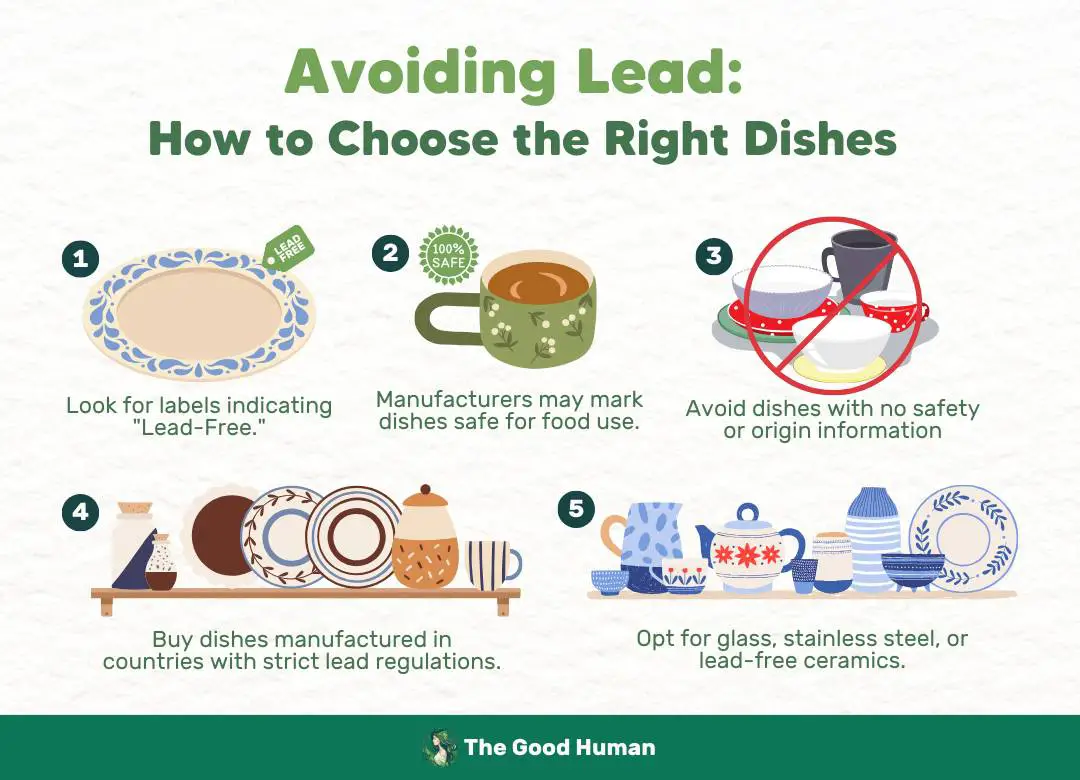
Use of home lead testing kits
As mentioned earlier, having a DIY lead testing kit is similar to having a reliable sword. These kits are your first line of defense, offering a quick way to screen your dishes for lead.
While not foolproof, they are an essential tool in your arsenal. Use them, especially on vintage or second-hand dishes, which carry a higher risk of lead content.
If the test is positive or even if you’re in doubt, consider sending the dishware for professional testing or, better yet, retire it from food use altogether.
Safe Storage and Preparation
Preparing and storing food safely is akin to mastering the art of culinary defense. Acidic foods and beverages are exceptionally skilled at coaxing lead out of dishes.
To minimize this risk, use glass or stainless steel containers for storing such items, especially if your dishware’s lead content is unknown. Similarly, when preparing hot foods, choose lead-free options to prevent lead leaching, preserving both the flavor and safety of your meals.
Regulatory Standards and Consumer Rights
Understanding regulatory standards and consumer rights regarding lead in dishes is crucial for ensuring the safety and health of individuals and families. These regulations are designed to limit the amount of lead in consumer products, including dishware, to protect public health.
Here’s an overview of the regulatory standards and consumer rights related to the presence of lead in dishes:
- United States: The U.S. Food and Drug Administration (FDA) sets specific limits on how much lead can leach from dishes into food. The FDA’s guidelines are based on the amount of lead that can be considered safe for daily intake. Ceramic tableware sold in the U.S. must meet these stringent lead release standards to be considered safe for use with food.
- European Union: The EU has similar regulations under the European Food Safety Authority (EFSA) framework, which also limits lead migration from ceramics and glassware into food. These standards are part of broader regulations concerning materials and articles intended to come into contact with food.
- International Standards: The International Organization for Standardization (ISO) and the World Health Organization (WHO) also provide guidelines and standards for ceramic lead content. However, adherence to these standards is voluntary for countries and manufacturers.
Conclusion
It’s important to remember that while the risk of lead exposure exists, proactive measures and awareness can significantly reduce it. Opting for dishes clearly labeled as lead-free, conducting your tests on suspect items, and practicing safe food storage and preparation are all steps in the right direction.
As we’ve seen, lead exposure can have profound health implications for everyone, especially children, pregnant women, and adults. By taking the necessary precautions outlined in this guide, you can enjoy your meals with peace of mind, knowing you’ve minimized the risk of lead exposure to you and your family.
Let this guide remind us of the power of informed choices and the importance of vigilance in protecting our health. Whether it’s heirloom ceramics or a recent thrift store find, ensuring the safety of your dishes is a crucial step in maintaining a healthy, lead-free home environment.

FAQs
Do all old dishes have lead?
Not all old dishes contain lead; it varies depending on the manufacturing process and materials used.
What is the easiest way to check if lead is present?
The easiest way to check for lead is by using a lead test kit, which involves applying a chemical swab to the dish and observing for a color change.
Is it safe to eat off vintage dishes?
Eating off vintage dishes may not always be safe if they contain lead, especially if they are used frequently or for acidic foods, which can leach lead more easily.

